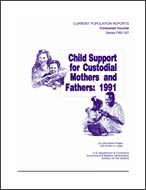Child Support for Custodial Mothers and Fathers: 1991
Child Support for Custodial Mothers and Fathers: 1991
Note
This report presents results from the April 1992 Child Support Supplement to the Current Population Survey (CPS). Some questions asked in the 1992 child support supplement are quite different than those asked in earlier supplements. The major differences are explained in Appendix A, ‘‘Changes to the 1992 Current Population Survey Child Support Supplement.’’ These differences represent a break in the April CPS data series. As a result, data from the April 1992 CPS are not strictly comparable to data for earlier years. This report refers only to the April 1992 results.
Introduction
This report provides information on the receipt of child support payments in 1991 by parents living with their own children whose other parents are absent following divorce or separation, and on the receipt of child support payments by never-married custodial parents. For the first time, data on custodial fathers were collected in the April 1992 supplement to the CPS, reflecting the growing need for information about men living with their own children whose mothers are absent from the household. In 1992, there were about 11.5 million custodial parents, 9.9 million of whom were custodial mothers and 1.6 million of whom were custodial fathers.
The April Child Support Supplement to the CPS is conducted by the Bureau of the Census and is sponsored, in part, by the Office of Child Support Enforcement, Department of Health and Human Services. The supplement surveys a sample of custodial parents 15 years old and over in the United States. This report compares child support and socioeconomic characteristics of custodial mothers and fathers to the extent that there was a sufficient sample to provide statistically reliable information.
All demographic surveys, including the CPS, suffer from undercoverage of the population. This undercoverage results from missed housing units and missed persons within sample households. Compared to the level of the 1990 Decennial Census, overall CPS undercoverage is about 8 percent. Undercoverage varies with age, sex, and race. For some groups, such as 20- to 24-year-old Black males, the undercoverage is as high as about 29 percent. The weighting procedures, used by the Census Bureau, partially correct for the bias due to undercoverage. However, its final impact on estimates is unknown. For details, see appendix B.
Others in Series
Publication
Publication
Publication




